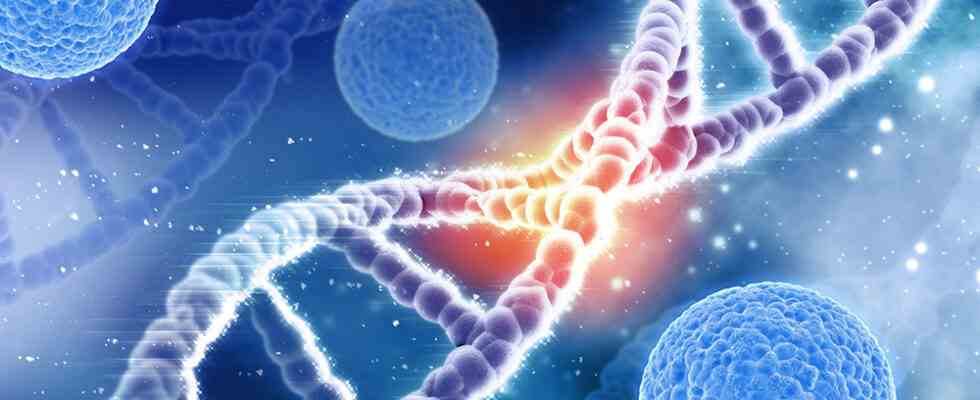Hidden activity: There are countless gene segments from ancient viruses in our genome. An analysis now shows that these endogenous retroviruses are actively read and transcribed – and that in healthy tissue throughout our body. The activity of the genetic virus residues in our brain and reproductive organs is particularly high. However, what exactly they do there and what effects the expression of this ancient viral DNA has is still unknown.
The human genome contains a series of sequences that actually have no place there: genes and gene fragments of viruses. This human endogenous retroviruses (HERV) make up around eight percent of our DNA and have long been suspected of influencing our health. Thus, the reactivation of these primeval pathogens could cause cancerous tumors and neurological diseases favor. Seem the other way around some HERVs also to protect against cancer and that muscle growth promoted by men.
Manhunt in 54 tissues from 1,000 people
However, it was previously unclear whether and when the virus residues will be read in our genome – and in which tissues. This is important because the endogenous retroviruses can still contain entire viral genes, but also DNA sequences that affect the activity of neighboring human genes. To clarify this, Aidan Burn of Tufts University in Boston and his colleagues examined samples from 1,000 people for the activity of endogenous retroviruses from the group HERV-K (HML-2).
This group of virus residues in our genome originates from primeval pathogens, the oldest representatives of which entered our genome around 35 million years ago, the youngest were integrated into human DNA 200,000 years ago. HML-2 can be found everywhere in our body. To trace the activity of these HERVs, the researchers analyzed 54 different types of tissue from different regions of the body. In addition, the samples included both healthy and diseased tissue.
Derivatives of endogenous retroviruses in all tissues
The surprising result: The virus residues of the HML-2 group were active in all tissues and parts of the body – regardless of whether the tissue was healthy or diseased. Overall, the researchers detected the RNA signatures of 37 different HML-2 virus residues. The RNA of five of these endogenous retroviruses was detectable in almost all tissues, but other HML-2 viral residues were only active in certain tissues, the team found.
“The presence of HML-2 transcripts and sometimes also viral genes can therefore be regarded as a normal part of our proteome and transcriptome – even in healthy tissue,” state Burn and his colleagues. Which of these endogenous retroviruses are active where and in whom apparently depends on age, gender and also on the virus residue.
Evolutionarily older viral remnants are more active
A clear correlation with the age of the virus remnants was shown: Those that have already entered the genome of the common ancestors of all great apes and humans are the most active in us humans today. They are read in almost all tissues, as the analyzes showed. On the other hand, the retroviruses that were first acquired from the common ancestors of humans and chimpanzees or even humans are only active in a few tissues.
“These data suggest that HERVs of different ages are controlled by the human genome to different degrees,” Burn and his colleagues explain. Older viral remnants have had more time to adapt to our DNA and cell machinery through mutation and selection. They could therefore have more opportunities to circumvent the control mechanisms and take action. At the same time, these HERVs may have persisted for so long because they have beneficial effects on our cells and tissues.
Highest expression in the brain and testes
There are also differences in relation to the tissues: “HML-2 expression varied considerably depending on the body part,” report Burn and his colleagues. They found by far the highest activity of the endogenous retroviruses in the cerebellum, the pituitary gland, the testicles and the thyroid gland. Other parts of the brain and nervous system also showed relatively high numbers of active HML-2 viral residues. HERVs, on the other hand, were hardly read in the blood and in the pancreas.
“These differences demonstrate that the intensity of expression for the HML-2 group is tissue-specific – some tissues and organs apparently favor the reading of these viral residues more than others,” the researchers state. They suspect that the virus residues in the thyroid and pituitary glands are activated by the hormones produced there.
The high activity in the testicles, on the other hand, could be related to the infection history of these viruses. According to current theory, most of the endogenous retroviruses, and HML-2 in particular, got into our genome when the corresponding retrovirus infected the germ cells and incorporated into their genome. These virus remnants are then passed on to the following generations via the sperm and egg cells infected in this way. “The predominant expression of younger proviruses in the reproductive tissue could reflect this,” the researchers explain.
“Still a mystery”
Overall, these results underscore that the endogenous retroviruses in our genome are more active than long thought. These virus residues are read even in healthy tissue and could therefore have countless as yet unrecognized influences on our health – both positive and negative. “The role of HERVs in human biology is still a mystery,” state Burn and his team.
“More research is needed to understand the mechanisms of their expression and also the differences in HERV activity between healthy and diseased tissues,” the researchers continue. “However, it is important to remember that HML-2 transcripts are always found in humans.” Earlier assumptions that active viral residues might be suitable as disease markers must take this into account. (PLoS Biology, 2022; doi: 10.1371/journal.pbio.3001826)
Source: PLOS

